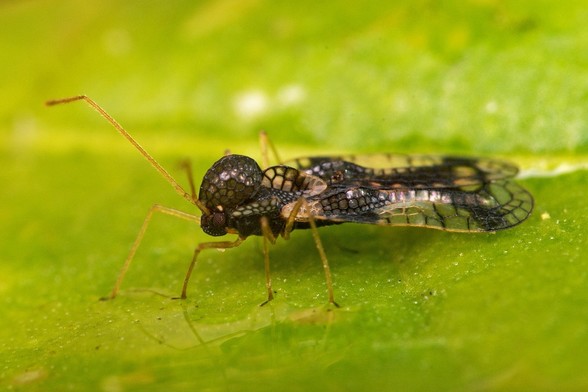Alexander H. Knudson Ph.D. · @Knudson_H
14 followers · 13 posts · Server ecoevo.socialHappy #TingidTuesday everyone! Sorry for the long lapse in posts! Here is Ambycysta championi (Drake). This species is the type of Ambycysta that was first described from #Brazil and has yet to be reported elsewhere. This specimen from
TAMU Entomology.
#Bugs #Tingidae
#tingidtuesday #brazil #bugs #tingidae
Alexander H. Knudson Ph.D. · @Knudson_H
15 followers · 12 posts · Server ecoevo.socialHow about another #TingidTuesday! Here is Dicysta vitrea Champion, the type species of the genus. This species was described from Panama. Later reported from Brazil, Paraguay, and Peru. Hosts plants included several different species of vining #Bignoniaceae. This specimen was collected near Chapada dos Guimarães, #Brazil by Herbert H. Smith. Specimen from CMNH. #Tingidae #bugs
#tingidtuesday #bignoniaceae #brazil #tingidae #bugs
Alexander H. Knudson Ph.D. · @Knudson_H
15 followers · 11 posts · Server ecoevo.socialWelcome to another #TingidTueday, Here is Nyctotingis cf. osborni Drake, the type species for the genus. Described from one specimen from Chapada, #Brazil. Subsequently reported from Ecuador & Peru. The only known host record is #Bamboo. Specimen from Monte L. Bean Collection at BYU. #Tingidae #bugs.
#tingidtueday #brazil #bamboo #tingidae #bugs
Milvus · @Milvus
129 followers · 612 posts · Server det.socialRT @A_Haselboeck
#Elasmotropis testacea aus der Familie der #Netzwanzen (#Tingidae). Oligophag an #Kugeldistel (#Echinops). In Deutschland bislang wohl nur im Osten und Süden an Echinops sphaerocephalus (Drüsiger Kugeldistel).
Lena hat sie schon gefunden 😀
https://twitter.com/LenaHalleSaale/status/1409495699868291074?t=ZW2ZqE0coFyquOp5YP2mbA&s=19
#elasmotropis #netzwanzen #tingidae #Kugeldistel #echinops #wanzen
Alexander H. Knudson Ph.D. · @Knudson_H
8 followers · 6 posts · Server ecoevo.socialHappy #TingidTuesday, I’ve been busy with job applications, manuscript reviews, and much-needed family time. Here is Dyspharsa uniseriata Cazorla & Knudson 2021 which was described from Trujillo and Merida states, Venezuela. 📷 from Cazorla & Knudson 2021. #Tingidae #Bugs The only congener, D. meyersi (Drake), was described from the Trinidad mountains in Cuba, not the island of Trinidad as listed by Drake and Ruhoff (1965). I can provide an English translation of the original description.
#tingidtuesday #tingidae #bugs
Andreas Haselböck · @A_Haselboeck
78 followers · 61 posts · Server mastodon.socialStephanitis takeyai, die Andromeda-Netzwanze (#Tingidae) stammt ursprünglich aus Japan. Nach Deutschland eingeschleppt wurde diese skurrile Wanzenart in den 1990er Jahren. Sie lebt an Rhododendron und Lavendelheide und ist von daher vor allem in Gärten und Parkanlagen mit den entsprechenden Wirtspflanzen zu finden.
matt parr · @mattparr
79 followers · 120 posts · Server mastodon.lolSince #TingidTuesday seems to be becoming a thing, here's one from the US Virgin Islands. No idea about ID but quite different from the Corythuchas I usually see in Philly. #Tingidae #Hemiptera
#tingidtuesday #tingidae #Hemiptera
Alexander H. Knudson Ph.D. · @Knudson_H
1 followers · 1 posts · Server ecoevo.socialHappy #TingidTuesday. Here is Eurypharsa farouki Silva, which was collected from a type of ground-dwelling vine near Correntina, Bahia
#Brazil. Excited to share that I am revising this genus😄Specimen from the United States National Museum of Natural History. Smithsonian Institution
#Tingidae.
#tingidtuesday #brazil #tingidae







